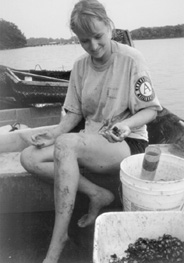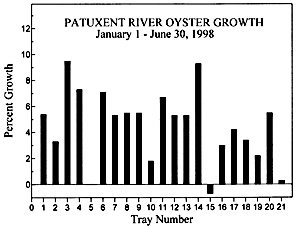
Dock of the Bay

Volume VI Number 33
August 20-26, 1998
In This Pax River Garden, Bearded Oysters Sprout
As we pulled up our oysters, we could tell from the weight of the tray that something was different. We swished it back and forth in the water, watching the silt swirl into the Patuxent near our dock. Only then were we able to lift the tray and ease it onto the boards.
Assistant oyster gardener Stephanie Linebaugh
raises seed oysters to planting size, at right.
The smell was horrendous. The oysters had grown beards, long strands of coarse vegetation masking the shells. Peeking through the greenery were barnacles, mussels and small nodules of a jelly-like organism. Small crabs crept away, flinging themselves from the dock. Summer had arrived at our oyster site, bringing with it the creatures and plant life spawned by warm waters.
We had been warned that warm weather would bring changes to our oysters and their environment. Now, the once-smooth, clean shells and tray were encrusted with mud as, armed with calipers and record sheets, we resumed our work as citizen scientists.
Last February, our job began (see NBT Feb. 26 - March 4) assisting Academy of Natural Science researchers in gathering data on oyster growth and mortality in the Patuxent River. On both shores of the river, from Solomons to Benedict, citizen scientists lowered from piers and docks wire baskets of oysters harvested from bars in the river. Come December, 35 survivors in each basket will be opened, dissected, cultured and stained with iodine.
Scientists George Abbe and Brian Allbright will be counting cells infected by a disease called dermo, which is killing the oyster population both in the river and the Bay. The growth of dermo - which has no effect on humans - seems to be related to the salinity of the water. Yet dermo has flourished from the salty mouth of the Chesapeake Bay into its less salty tributaries.
Now scientists are trying to find out what forces encourage dermo.
At this halfway point, not much had happened, Abbe and Allbright reported after analyzing the data collected by their citizen scientists. That was just what had been expected.
In cold weather, neither oysters nor dermo is up to much (see chart for our oysters' half-year progress). By June, most of an oyster's energy goes into building gonadal tissue for reproduction. From outside the shell, the oyster looks the same, but inside much is going on. During July, the oyster spawns. After spawning comes growth. A small soft rubbery crest builds up at the shell's edge, something like a tree's growth ring, as we noted when we measured our oysters.
Growth continues from July to December, both outside and inside, as the oyster feeds during summer months and begins to store fat for winter. That's why, by November, oysters become plump, tasty morsels. During those same months, dermo also increases, leading to higher mortality.

Site 1 is at the mouth of the Patuxent where salinity is highest. Site 21 is near the Benedict Bridge where salinity is less. Fresh water enters the river from a nearby stream and the oyster tray, tipped over during one of the storms, crowded the oysters together. Site 5 no longer exists; oyster bandits have raided it successfully. Site 15 contains small oysters thought to be from a reseeding project on the Broomes Island oyster bar. Site 14 also contains oysters from Broomes Island oyster bar, (the same as Site 15), but the oysters are older, bigger and possibly native to the area.
We'll know more - and have to work harder - when we pull up our heavy tray of autumn oysters.
If becoming a citizen sleuth appeals to you, here are some projects that can always use volunteers.
-Carol Glover
Contributing Editor Glover is also a Patuxent oyster citizen scientists.
Surely You Joust: MD's Sport a Ringer for Diversions & Excursions
 photo by Isabel J. Kurek Jousting
is as old as knights depicted by Medieval Horse Guilders Bruce and Robin
Scarborough.
photo by Isabel J. Kurek Jousting
is as old as knights depicted by Medieval Horse Guilders Bruce and Robin
Scarborough.
Maryland's official state sport is the oldest equestrian sport in the world. Which means that at 132 years old, The Calvert County Jousting Tournament -- a county fund-raiser for civic and church organizations that dates nearly back to the Civil War -- is a mere upstart. Still, its annual end-of-summer return to the picturesque grounds of Christ Episcopal Church on Broomes Island Road is something of an event.
The competitors call themselves names that conjure up romantic visions of King Arthur's Court: The Knight and Lady of Sandy Point, the Maid of Sleepy Hollow, the Maid of North Beach, little Brittany Colliflower. They are fathers and sons, ladies and maidens, waiting their turn to test their skills by spearing small brass rings while riding their favorite steed.
Keeping one eye closed with the other on rings as small as one-half inch in diameter while holding steady the reins of a gently galloping horse is serious business. The concentration is infectious: all hold their breath as the riders charge down the dirt track toward the three arches, each dangling a metal ring wrapped in white cord.
There's a lot of pageantry in this sport of kings and maids and knights; it's a fine way to end the summer. Last year's Labor Day tournament at Christ Episcopal Church drew several thousand spectators, according to Peter Cochran, an organizer and church member. Proceeds benefit the historic church, as they have for nearly the last half century.
But summer's end won't be an end to the jousting. Tournaments continue from August into October. Take your pick.
-M.L. Faunce
Dry Days of Summer Spark Wildfires
A decade ago, Yellowstone National Park burst into flames extinguished only weeks later by snowfall. This year, the year of El Niño, Mother Nature's fiery wrath is wider.
A nationwide drought is kindling wildfire from Washington State in the north to Florida in the Southeast and Texas in the Southwest. While fire has not yet scorched Maryland, heat and drought have turned much of the state into tinder.
July's record high global surface temperatures are likely to make 1998 the warmest year ever recorded. In those 31 days, the Baltimore area had only 3.23 inches of rainfall, not enough to moisten our dry land. Thirsty grass and trees become fire hazards in a time like this.
"For the last couple of weeks we've experienced an increase in burning
activities due to the drought," says Maryland Department of Natural
Resources Forest Ranger Will Williams.
Most of Maryland's recent breakouts have been small, but in Jessup, a fairly large roadside fire burned nearly 10 acres. Williams, who has fought fires across the country, including Yellowstone, believes a tossed cigarette butt was the likely cause.
Unlike Yellowstone or Florida's lightning-ignited fires, most of Maryland's breakouts - 99 percent, according to Williams - are man made.
"The three major wildfire causes are arson, careless debris burning and children playing with matches," Williams says. One spark is enough to ignite a vicious inferno during this drought.
The remaining one percent are due to lightning bolts, campfires and smoking, equipment use and railroad operations.
Many wooded communities in Anne Arundel and Calvert counties are vulnerable. The most sensitive are those with little green grass between the home and woodland.
The forest ranger warns that keeping yards and gutters free of leaves and debris is key to keeping your home safe. Stack firewood away from the structure and keep smoke detectors working. Williams also advises marking your address clearly so, in case of fire, firefighters can find your home quickly.
Finally, devise a disaster plan for your home. Have yours ready for The Great Escape on October 7. Then, as part of Fire Prevention week, you can join the National Fire Protection Association at 6pm in making good your part of The Great Escape national fire drill.
That's a good way to avoid joining such statistics as these: In 1996, nearly five thousand Americans perished in 1,975,000 fires.
-Darcey Dodd
In Buffalo Gap, Va., the "Granddad of Eastern Wilderness" has died. Ernest Dickerman was a lobbyist for the Wilderness Society and president of the Smoky Mountains Hiking Club. He was credited with blocking oil drilling in Virginia's George Washington National Forest. He has been an adviser to many conservationists since retiring in 1976. He was 87 ...
In California, Navy researchers want to send their environmental sensibilities into space. They have developed a new non-polluting rocket fuel using alcohol to ignite hydrogen peroxide. They're hoping that a similar technology can be developed for autos ...
In New England, the "Give Swordfish a Break" campaign is hitting home. It is off this Atlantic coast in a rich fishery called George's Bank where most swordfish are netted. The boycott came about because of overfishing and, as a result, 250 U.S. restaurants and food establishments have banned swordfish from their menus ...
At Virginia Tech University, a study suggests that populations of birds such as the Eastern meadowlark and the field sparrow have declined because farmers are planting more exotic grass species rather than native grasses. The study was presented last month in Baltimore at a meeting of the Ecological Society of America ...
Our Creature Features comes from Falker Island, Conn., where the actions of a lonely lighthouse keeper 20 years ago are causing problems today.
To keep him company, the unidentified keeper brought a pair of pet bunnies to the island. He may have understood weather and ocean currents but he didn't know much about rabbits. The Boston Globe reports that today, Falker Island is overrun by rabbits, creating erosion problems and crowding out other wildlife.
But rather than uncasing their shotguns, the new managers have an idea they may try shortly: feeding the rabbits food laced with contraceptive chemicals.
| Back to Archives |
Volume VI Number 33
August 20-26, 1998
New Bay Times
| Homepage |